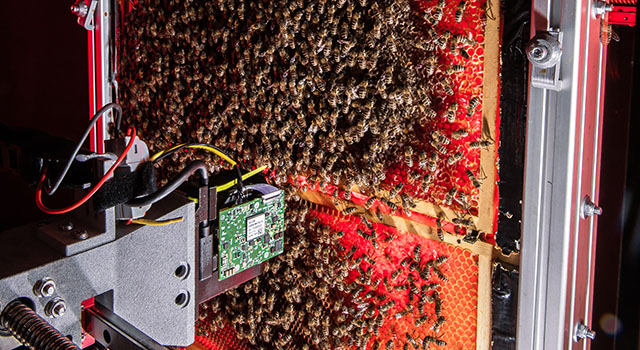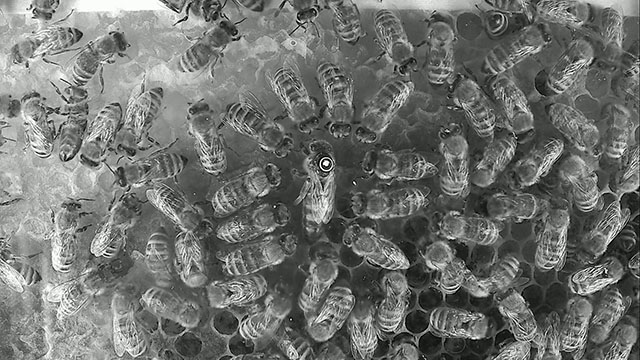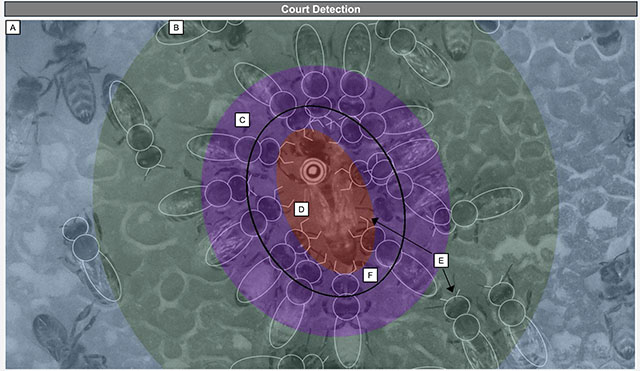
Researchers at the METU Center for Robotics and Artificial Intelligence (ROMER), in collaboration with their international partners from England, Czech Republic, and Austria, have developed a system that enables tracking and analysis of honey bee behaviors through robotics and artificial intelligence technologies as part of the EU project titled RoboRoyale.
 The research article titled “Autonomous Tracking of Honey Bee Behaviors Over Long-Term Periods with Cooperating Robots,” co-authored by researchers from METU, Durham University, University of Graz, and Czech Technical University, was published in the October issue of Science Robotics. The system developed by the research team allows for the intelligent tracking of the queen bee, worker bees, and brood within the nesting cells of the hive through computer vision, making it possible to identify fundamental bee behaviors. The initial analysis results of the data collected by this system were presented in the article, whose authors include METU faculty members Assoc. Prof. Erol Şahin and Assoc. Prof. Hande Alemdar from the Department of Computer Engineering, Assoc. Prof. Ali Emre Turgut from the Department of Mechanical Engineering, as well as METU researchers Bilal Yağız Gündeğer, Erhan Ege Keyvan, and Babür Erdem, all of whom are also members of METU-ROMER. The robotic system enables the monitoring of both sides of a specially designed, transparent glass-walled “observation hive,” in which a colony of honey bees naturally going outside to forage from flowers resides. During the observation process, one of the cameras tracked the queen bee, while the other mapped the hive cells filled with brood, pollen, or honey. In order to avoid impacting the behaviors of bees, high-resolution recordings were made under infrared light and then analyzed with various artificial intelligence algorithms.
The research article titled “Autonomous Tracking of Honey Bee Behaviors Over Long-Term Periods with Cooperating Robots,” co-authored by researchers from METU, Durham University, University of Graz, and Czech Technical University, was published in the October issue of Science Robotics. The system developed by the research team allows for the intelligent tracking of the queen bee, worker bees, and brood within the nesting cells of the hive through computer vision, making it possible to identify fundamental bee behaviors. The initial analysis results of the data collected by this system were presented in the article, whose authors include METU faculty members Assoc. Prof. Erol Şahin and Assoc. Prof. Hande Alemdar from the Department of Computer Engineering, Assoc. Prof. Ali Emre Turgut from the Department of Mechanical Engineering, as well as METU researchers Bilal Yağız Gündeğer, Erhan Ege Keyvan, and Babür Erdem, all of whom are also members of METU-ROMER. The robotic system enables the monitoring of both sides of a specially designed, transparent glass-walled “observation hive,” in which a colony of honey bees naturally going outside to forage from flowers resides. During the observation process, one of the cameras tracked the queen bee, while the other mapped the hive cells filled with brood, pollen, or honey. In order to avoid impacting the behaviors of bees, high-resolution recordings were made under infrared light and then analyzed with various artificial intelligence algorithms.
The system, operating in a research laboratory on the campus of the University of Graz as well as at METU-ROMER, generated approximately 1.4 terabytes of data daily. This data, consisting of high-resolution real-time footage of the queen bee’s interactions with worker bees, was stored for detailed analysis by project partners. The analysis of the collected data has made it possible to uncover the behavioral interactions within the colony and to gain a better understanding of the social behaviors inside the colony.

For the first time, this robotic system has made it possible to collect continuous, real-time, and highly accurate data on the activities within the hive over long-term periods. Through the analysis of the collected data with artificial intelligence, intriguing findings were reported on 23 distinct behavioral patterns that could be characterized as “Key Behavioral Metrics” for the bees.
With over 100 million recorded images, analyzing this data solely with the human eye was impossible; therefore, artificial intelligence technologies were utilized in the analysis process. Through the algorithms, information was obtained on the queen’s movements and egg-laying patterns, as well as the total number of worker bees in the hive. Additionally, the system made it possible to create a continuously updated map of the hive including brood, pollen, and honey, in order to measure the success rate of reproduction.
The article, published on October 16 in Science Robotics, one of the most prominent journals in its field, presents some remarkable findings, such as the queen bee covering approximately 1.5 kilometers within the hive over the course of a month, resting for a total of 1.5 hours at regular intervals, and laying an average of 187 eggs per day, even in October, which marks the end of the bee season.

Amos Matsiko, one of the journal’s editors, noted that honeybees are essential for the pollination of food crops; however, their populations have been declining recently due to various environmental factors, including habitat loss. Matsiko explained that although previous scientific studies had attempted to understand honey bee behavior in their natural hive environments, these efforts were unsuccessful. He highlighted that this research article presents the development of an autonomous robotic system capable of continuously monitoring and tracking honey bees over a period of 30 days. Matsiko emphasized that this system could play a crucial role in identifying the basic behavioral characteristics of the queen bee, worker bees, and brood, in developing strategies for the conservation of this species.
The data collected as part of the RoboRoyale project is expected to be used in a variety of other analyses in the future.
Through this recently developed system, researchers have demonstrated that robotics and artificial intelligence technologies provide an unprecedented means of information acquisition for studies in behavior and ecology within different biological systems. The project team aims to expand these digital methods in future endeavors focused on other animal and plant species, thus being able to gain a deeper understanding of complex ecosystems.
The published research article can be accessed here, and further details about the project are available here.







